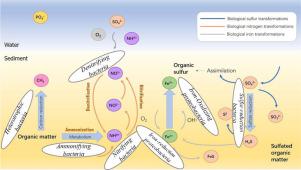Environmental Technology & Innovation ( IF 6.7 ) Pub Date : 2021-07-13 , DOI: 10.1016/j.eti.2021.101793 Zhifeng Hu 1 , Hong Yao 1 , Desheng Li 1

|
In situ sediment remediation is commonly used for controlling the release of pollutants (N, P, C and S) from polluted urban river sediments. The addition of oxidants can effectively solve the odor problem and control the conversion of sulfur in sediments. Laboratory experiments were established to explore the effect of improving contaminated urban river sediment quality with hydrogen peroxide, calcium nitrate, calcium hypochlorite and iron-based substrate (IRS). The results verified that the redox potential increased to 161 mV and 90 mV after 30 days of calcium hypochlorite and calcium nitrate treatment, respectively. The addition of calcium hypochlorite or calcium nitrate reached 97.9% and 94.8% high removal efficiency of acid volatile sulphide due to the oxidation. The addition of IRS decreased the ammonia and total organic carbon concentrations, indicating that the IRS were conducive to controlling the release of 73.2% of the total nitrogen (TN) from river sediment. The consequence also showed that compared with other oxidants, IRS had remarkable influences on the interstitial sulphate, iron and nitrate contents in the sediment, clearly showing comprehensive application prospects.
中文翻译:

基于富铁底物修复污染城市河流底泥:与化学氧化剂的比较研究
原位沉积物修复通常用于控制污染的城市河流沉积物中污染物(N、P、C 和 S)的释放。氧化剂的加入可以有效解决臭味问题,控制沉积物中硫的转化。建立了实验室实验,探讨了过氧化氢、硝酸钙、次氯酸钙和铁基底物(IRS)改善受污染城市河流底泥质量的效果。结果证实,在次氯酸钙和硝酸钙处理30天后,氧化还原电位分别增加到161 mV和90 mV。次氯酸钙或硝酸钙的加入对氧化引起的酸性挥发性硫化物的去除效率分别达到97.9%和94.8%。IRS 的加入降低了氨和总有机碳浓度,表明 IRS 有利于控制河流沉积物中 73.2% 的总氮 (TN) 的释放。结果还表明,与其他氧化剂相比,IRS对沉积物中间隙硫酸盐、铁和硝酸盐含量有显着影响,显示出综合应用前景。











































 京公网安备 11010802027423号
京公网安备 11010802027423号